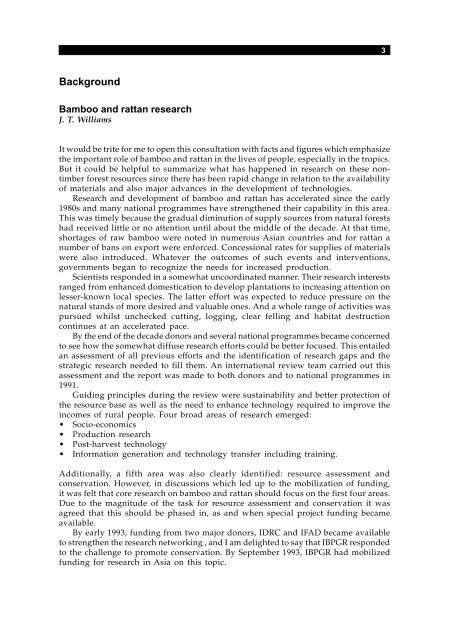Priority species of bamboo and rattan - Bioversity International
Priority species of bamboo and rattan - Bioversity International
Priority species of bamboo and rattan - Bioversity International
You also want an ePaper? Increase the reach of your titles
YUMPU automatically turns print PDFs into web optimized ePapers that Google loves.
Background<br />
Bamboo <strong>and</strong> <strong>rattan</strong> research<br />
J. T. Williams<br />
It would be trite for me to open this consultation with facts <strong>and</strong> figures which emphasize<br />
the important role <strong>of</strong> <strong>bamboo</strong> <strong>and</strong> <strong>rattan</strong> in the lives <strong>of</strong> people, especially in the tropics.<br />
But it could be helpful to summarize what has happened in research on these nontimber<br />
forest resources since there has been rapid change in relation to the availability<br />
<strong>of</strong> materials <strong>and</strong> also major advances in the development <strong>of</strong> technologies.<br />
Research <strong>and</strong> development <strong>of</strong> <strong>bamboo</strong> <strong>and</strong> <strong>rattan</strong> has accelerated since the early<br />
1980s <strong>and</strong> many national programmes have strengthened their capability in this area.<br />
This was timely because the gradual diminution <strong>of</strong> supply sources from natural forests<br />
had received little or no attention until about the middle <strong>of</strong> the decade. At that time,<br />
shortages <strong>of</strong> raw <strong>bamboo</strong> were noted in numerous Asian countries <strong>and</strong> for <strong>rattan</strong> a<br />
number <strong>of</strong> bans on export were enforced. Concessional rates for supplies <strong>of</strong> materials<br />
were also introduced. Whatever the outcomes <strong>of</strong> such events <strong>and</strong> interventions,<br />
governments began to recognize the needs for increased production.<br />
Scientists responded in a somewhat uncoordinated manner. Their research interests<br />
ranged from enhanced domestication to develop plantations to increasing attention on<br />
lesser-known local <strong>species</strong>. The latter effort was expected to reduce pressure on the<br />
natural st<strong>and</strong>s <strong>of</strong> more desired <strong>and</strong> valuable ones. And a whole range <strong>of</strong> activities was<br />
pursued whilst unchecked cutting, logging, clear felling <strong>and</strong> habitat destruction<br />
continues at an accelerated pace.<br />
By the end <strong>of</strong> the decade donors <strong>and</strong> several national programmes became concerned<br />
to see how the somewhat diffuse research efforts could be better focused. This entailed<br />
an assessment <strong>of</strong> all previous efforts <strong>and</strong> the identification <strong>of</strong> research gaps <strong>and</strong> the<br />
strategic research needed to fill them. An international review team carried out this<br />
assessment <strong>and</strong> the report was made to both donors <strong>and</strong> to national programmes in<br />
1991.<br />
Guiding principles during the review were sustainability <strong>and</strong> better protection <strong>of</strong><br />
the resource base as well as the need to enhance technology required to improve the<br />
incomes <strong>of</strong> rural people. Four broad areas <strong>of</strong> research emerged:<br />
• Socio-economics<br />
• Production research<br />
• Post-harvest technology<br />
• Information generation <strong>and</strong> technology transfer including training.<br />
Additionally, a fifth area was also clearly identified: resource assessment <strong>and</strong><br />
conservation. However, in discussions which led up to the mobilization <strong>of</strong> funding,<br />
it was felt that core research on <strong>bamboo</strong> <strong>and</strong> <strong>rattan</strong> should focus on the first four areas.<br />
Due to the magnitude <strong>of</strong> the task for resource assessment <strong>and</strong> conservation it was<br />
agreed that this should be phased in, as <strong>and</strong> when special project funding became<br />
available.<br />
By early 1993, funding from two major donors, IDRC <strong>and</strong> IFAD became available<br />
to strengthen the research networking , <strong>and</strong> I am delighted to say that IBPGR responded<br />
to the challenge to promote conservation. By September 1993, IBPGR had mobilized<br />
funding for research in Asia on this topic.<br />
3

















